
Tanks
Here's the place to explore types of tanks, options for aboveground tanks, evaluating underground tanks, and tank regulations.
A heating oil storage tank offers an important advantage to the homeowner, an ample supply of heating oil stored on their property and ready for immediate use whenever needed.
Tank Locations
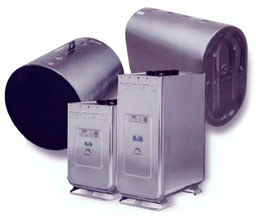 Oil storage tanks, either aboveground or underground tanks, can be found in three locations:
Oil storage tanks, either aboveground or underground tanks, can be found in three locations:
- An aboveground tank may be inside the home, usually in the basement, utility room or garage. The most common tank is the 275-gallon basement tank.
- Some aboveground tanks are located outside the home, either in the rear of or at the side of the house. Like indoor tanks, these tanks usually hold 275 gallons of oil.
- Underground tanks are found in various locations outside the home, buried in the yard. They are usually larger than aboveground tanks, holding 550 or 1,000 gallons of fuel.
Common Misconception:
Tank leaks are common and lead to financial ruin.
Truth: Every once in a while there will be a news story about a major oil leak that's reported in a way that tends to sensationalize the issue and negatively shape perceptions. Most leaks can be prevented if tanks are properly maintained and replaced when testing has shown they have reached the end of their life span. In some states, there is a public fund for covering any cleanup costs that result from leaks. In other states, private insurance or a tank protection program may be useful to the homeowner.
Options for Aboveground Tanks
The term "aboveground tank" refers to any tank not buried in the ground. Most oil tanks are now built with corrosion-resistant materials. The newest generation of aboveground tanks generally can be installed in small or unusually shaped spaces in basements or garages. Tanks can also be installed outdoors and protected by a tank enclosure. Many new heating oil tanks are also being installed below ground using new, innovative technologies.
Evaluating an Underground Tank
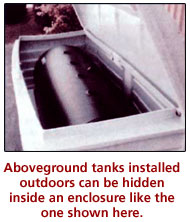 Although leaks do occur in residential oil tanks, they are rare. NORA has developed a simple evaluation procedure for underground tanks, and there are many competent tank testing companies who can assist you in evaluating your tank.
Although leaks do occur in residential oil tanks, they are rare. NORA has developed a simple evaluation procedure for underground tanks, and there are many competent tank testing companies who can assist you in evaluating your tank.
In addition to the tank, any heating oil storage system (aboveground or underground tank) includes the fill pipe and the vent pipe. The oil driver connects the hose from the delivery truck to the fill pipe when making a delivery of fuel. The vent pipe releases air pressure from the tank as it's filled. Generally, the terminus of the fill pipe and vent pipe are outdoors and near each other. The National Fire Protection Association (NFPA) requires inside tanks to have an audible device (generally called a vent alarm) that indicates when, during a delivery, the tank reaches its fill point.
Types of Tanks
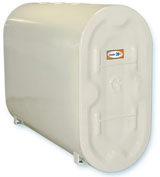 The Oilheating industry has been developing a variety of tanks to ensure that the oil is safely contained.
The Oilheating industry has been developing a variety of tanks to ensure that the oil is safely contained.
Steel Tanks
Steel tanks built to rigorous Underwriters Laboratory (UL®) specifications are the mainstay of the industry. They are the most commonly installed tanks and have proven themselves over decades of use. They can be installed aboveground or underground.
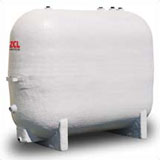 Fiberglass Tanks
Fiberglass Tanks
Fiberglass tanks are built to rigorous Underwriters Laboratory (UL®) specifications. They have become increasingly popular for underground installations. Additionally, a fiberglass tank has recently passed UL®'s fire test and can now be installed aboveground.
Combined Tanks
Another popular tank system is a combined plastic and steel tank. The plastic tank serves as an inside liner for storing the fuel, and this is protected by an outside steel jacket. This tank is also built to rigorous Underwriters Laboratory (UL®) specifications. This tank design has been used in Europe for decades.
Tank Improvements
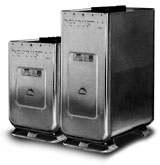 The Oilheating industry has been working for decades to ensure that tanks are safe. Any tank that is installed aboveground must be able to withstand a severe fire. In testing the tanks, they are put in a diesel fire for 30 minutes, and cannot leak during that time period. These tanks are designed to ensure that they will not contribute to a house fire.
The Oilheating industry has been working for decades to ensure that tanks are safe. Any tank that is installed aboveground must be able to withstand a severe fire. In testing the tanks, they are put in a diesel fire for 30 minutes, and cannot leak during that time period. These tanks are designed to ensure that they will not contribute to a house fire.
Additionally, to ensure leaks are rare, some steel tanks are covered in composites that make them more attractive, and essentially provide a second barrier. Some manufacturers now produce double-bottom tanks with leak detectors to virtually eliminate the chance of a leak.
How Long Does a Tank Last
The industry has been studying that for many years, and unfortunately there is not an absolute answer.
Underground tanks may corrode. However, that rate of corrosion is affected by the type of soil the tank is in, how often it rains, whether there are rocks or left over construction waste near the tank. People have reported tanks in good condition that are many decades old. However, and unfortunately, some tanks have failed earlier. Signs of a leak may be water in the tank (water will often flow into the tank if it has lost its integrity), increased consumption of oil, and burner problems. If you are concerned about a leak, talk to your dealer, who can use several means to evaluate whether the tank is sound.
Aboveground tanks may also corrode, however they usually corrode from the inside out. This is due to water entering the tank from air condensing in the tank. To avoid this, we recommend having the tank filled before the days of summer get humid. Additionally, current fire regulations require aboveground tanks to have a fill at the bottom. This allows tanks installed indoors to drain off water as the burner operates.
If the tank is corroding, there will generally be wet spots, dust spots, or an oil smell near the tank. If you are concerned, you may want to call your dealer.
Tank Installations and Maintenance
The industry has been working with the National Fire Protection Association and Underwriters Laboratory to ensure new tanks are safe and properly installed. The National Fire Protection Association has a comprehensive installation guide for tanks. This includes line protection for the fuel lines, anti-leak devices on the lines, where the tank can be installed, how the fill pipes and vents should be installed, and many other important requirements.
Additionally, the industry has been working to ensure the service technicians in your home will be able to inspect your tank, and ensure there are no developing problems. The National Oilheat Research Alliance has published a book and developed a comprehensive training program to ensure that having a tank in your home does not create concerns.
Tank Regulations
In the U.S., all underground residential heating oil tanks, regardless of size, are exempt from all federal and most state regulations.
Oil storage systems must comply with local fire ordinances; many municipalities have adopted NFPA standards in their building codes. For questions about a particular installation, call the local building department or a qualified heating contractor.


